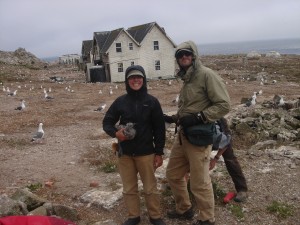Hello again from the Farallons!
In the past few weeks we have been continuing/finishing up our studies on the various seabirds here. It was also recently my turn to update the official Farallon Island blog, here is a link to my post there: http://losfarallones.blogspot.com/2010/07/baby-chicks-diet-watchcollection.html
We finished Common Murre diet watch! Technically we were supposed to continue diet watch until only 10 chicks were in the plot, but because there were SO many feedings this year, our data’s sample size included over 7000 feedings (as compared to last year’s 1500 feedings), so Russ and Pete officially said we had plenty of data to work with.
Also, I dont know if I’ve mentioned this previously, but another one of Katrina’s studies that I took over when she unexpectedly left was her gull plot (H-East).
In gull studies, we follow gulls of known age (they are banded birds). They essentially claim a territory that they maintain throughout the season (usually for their lifetime, with their mate), and we have a special labeling system to identify them, and we monitor their breeding attempts.
You can resight gulls to! Here’s how (banded birds hang out a lot in San Francisco locales, like AT&T park, the SF zoo, Golden Gate Park, places where there is food, etc): You can first tell what year the bird hatched by its color combination, and you’re likely to see gulls between 3-15 years old (they have been known to live much longer, some of the gulls in my plot are way older than me!) we use a code that gives the order of the bands by upper left (upper band on the left leg) lower left (lower band on left leg), upper right, lower right. For example, blue-yellow-metal-nothing indicates a bird that has a blue band on its left leg above a yellow band also on its left leg, and only a metal band on its right leg. (Metal bands also have a number that you can usually read with some binoculars. If you actually see a bird and record its combo AND number, you can let the folks at PRBO.org know and they would be thrilled to hear about it!)
I’ll list the hatch year and the combo here starting with 1986:
1986: yellow-metal-nothing-nothing
1987: blue-metal-nothing-nothing
1988: green-metal-nothing-nothing
1989: black-metal-nothing-nothing
1990: reddishbrown-metal-nonthing-nothing
1991: gray-metal-nothing-nothing
1992: nothing-nothing-yellow-metal
1993: nothing-nothing-white-metal
1994: nothing-nothing-tan-metal
1995: nothing-nothing-green-metal
1996: white-nothing-metal-nothing
1997: nothing-nothing-blue-metal
1998: nothing-nothing-black-metal
1999: nothing-nothing-gray-metal
2000: yellow-nothing-metal-nothing
2001:blue-nothing-metal-nothing
2002: green-nothing-metal-nothing
2003: black-nothing-metal-nothing
2004: red-nothing-metal-nothing
2005: gray-nothing-metal-nothing
2006: metal-nothing-yellow-nothing
2007: metal-nothing-blue-nothing
2008: metal-nothing-white-nothing
2009: metal-nothing-green-nothing
2010: metal-nothing-black-nothing
So that means this year, all the chicks that are hatching are getting banded with a metal band (with numbers) on its left leg and a black plastic band on its right leg. After we band all the “followed” chicks (chicks hatched to at least one parent that had a band, thus of known-age, that bred within the plot boundaries), we choose a day where we do “saturation banding”, which is where we band ALL of the chicks, regardless of whether or not their parents have bands, within the plot boundaries. We don’t just band all the chicks on the island because we only band birds we expect to have to resight later and know the age of, and since western gulls tend to breed in the same plot they were hatched in, we only band within the plot.
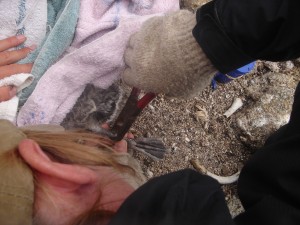 This is Melinda banding a gull chick. Banding gull chicks takes teamwork. Other species breed in crevices, burrows, or study boxes designed for animal-handling, but gulls breed out in the open and their chicks roam around. In order to handle a gull chick without scaring it (which causes it to run really fast away from us and into another gull’s usually-hostile territory), we have to circle it and slowly and gradually close in on it from all sides with towels, and as we get really close, one of us flings our towel on top of the gull which usually immediately calms it down (they like to be “hidden”), and then we can band it. Sometimes they fidget, which is why my hand is holding down this gull chick in the picture.
This is Melinda banding a gull chick. Banding gull chicks takes teamwork. Other species breed in crevices, burrows, or study boxes designed for animal-handling, but gulls breed out in the open and their chicks roam around. In order to handle a gull chick without scaring it (which causes it to run really fast away from us and into another gull’s usually-hostile territory), we have to circle it and slowly and gradually close in on it from all sides with towels, and as we get really close, one of us flings our towel on top of the gull which usually immediately calms it down (they like to be “hidden”), and then we can band it. Sometimes they fidget, which is why my hand is holding down this gull chick in the picture.
Sometimes, the gulls breed really close to other study sites, and when we check on these study sites, the gull chicks get scared and want to run away, so one of us has to hold on to the gull chick while the rest of us take/record data. Here is Jessie holding a gull chick while Michelle in the bottom left checks on a Rhinocerous Auklet box, and Russ next to Jessie.
After reading all that text, I’ll bet you want to see some more pictures, right???
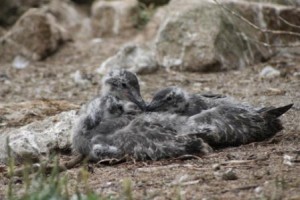 Three gull chicks, mostly feathered, roosting together.
Three gull chicks, mostly feathered, roosting together.
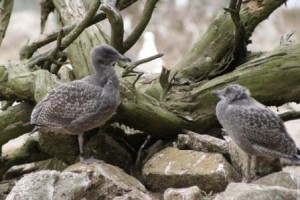 Two fully feathered chicks standing. They reach their adult plumage at about 2 years of age, and don’t start breeding until they’re about 4 or 5 years old.
Two fully feathered chicks standing. They reach their adult plumage at about 2 years of age, and don’t start breeding until they’re about 4 or 5 years old.
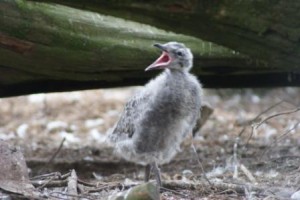 A gull chick begging for food from its parent, not pictured.
A gull chick begging for food from its parent, not pictured.
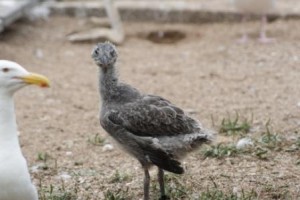 For some reason, some of the chicks can’t tuck their wings in properly, and their wings are always sagging and drooping. We don’t really know why this is happening, but its likely due to poor nutrition or some kind of contamination during the egg forming or incubation period. I personally think they are zombie gulls.
For some reason, some of the chicks can’t tuck their wings in properly, and their wings are always sagging and drooping. We don’t really know why this is happening, but its likely due to poor nutrition or some kind of contamination during the egg forming or incubation period. I personally think they are zombie gulls.
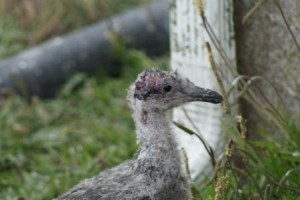 Poor parenting leads to injured or dead chicks. This chicks parents for some reason dont defend their territory regularly, and when they’re gone, this little chick gets beat up on by its neighbors. It’s still alive, though!
Poor parenting leads to injured or dead chicks. This chicks parents for some reason dont defend their territory regularly, and when they’re gone, this little chick gets beat up on by its neighbors. It’s still alive, though!
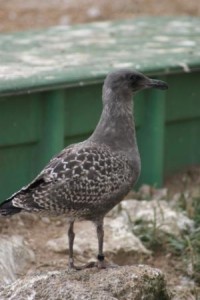 This is “Bobby”, one of the oldest chicks on the island. He’s totally fully-feathered and can fly nowadays, but as any chick would logically do, still returns to his parents territory as long as his parents still feed him when he begs. We try to refrain from naming the birds so that we don’t get too attached, but sometimes you can’t help it (and he wasnt a study bird).
This is “Bobby”, one of the oldest chicks on the island. He’s totally fully-feathered and can fly nowadays, but as any chick would logically do, still returns to his parents territory as long as his parents still feed him when he begs. We try to refrain from naming the birds so that we don’t get too attached, but sometimes you can’t help it (and he wasnt a study bird).
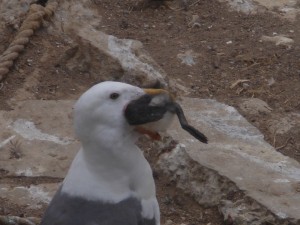 This WEGU found a meal of one of the Common Murre chicks. This is why you can’t get too attached to any wildlife. Wildlife are not pets. This is a common misconception amongst many people who dont understand why we don’t attempt to “save” every organism on the island. If we save all the chicks from much of their inevitable death, you get population explosions and then a concurrent resource depletion, leading to a population crash. Also, if you save all the chicks from the gulls, then some of the gulls might starve. Also, saving chicks from death wouldn’t allow us to study them at all since we wouldn’t be getting any idea about the birds ability to raise their own young. We are here to observe and report, not to interfere and meddle with complex food webs that we are still attempting to learn about.
This WEGU found a meal of one of the Common Murre chicks. This is why you can’t get too attached to any wildlife. Wildlife are not pets. This is a common misconception amongst many people who dont understand why we don’t attempt to “save” every organism on the island. If we save all the chicks from much of their inevitable death, you get population explosions and then a concurrent resource depletion, leading to a population crash. Also, if you save all the chicks from the gulls, then some of the gulls might starve. Also, saving chicks from death wouldn’t allow us to study them at all since we wouldn’t be getting any idea about the birds ability to raise their own young. We are here to observe and report, not to interfere and meddle with complex food webs that we are still attempting to learn about.
Alright, on to a different species.
Yesterday, I brought my camera out with us during a routine Cassin’s Auklet check to document a little.
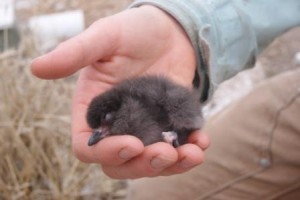 This is a very very tiny Cassin’s Auklet chick that was left alone a little earlier than it should have by its parent. We really really quickly took a weight and a very quick picture before hurriedly putting it back.
This is a very very tiny Cassin’s Auklet chick that was left alone a little earlier than it should have by its parent. We really really quickly took a weight and a very quick picture before hurriedly putting it back.
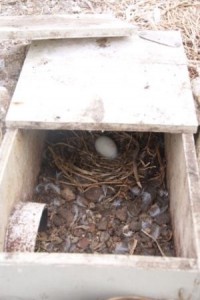 What a clean and organized box! Nice job, Cassin’s! This is a study box we use for Cassins. The top is kept covered with a shade and rocks on top so a gull can’t knock off the top and steal whats inside (we try to imitate the safety of the burrows Cassin’s usually dig out), and it has a tunnel that serves as an entrance/exit they use. When we check the boxes, we cover the tunnel with our knee or foot, and carefully lift up the top to look at the contents. Usually once a chick is hatched the box has a ton of poop and doesnt look this pretty. When an adult is first incubating its leg we check to see if the adult is banded and if it is of known-age, we take some measurements to record.
What a clean and organized box! Nice job, Cassin’s! This is a study box we use for Cassins. The top is kept covered with a shade and rocks on top so a gull can’t knock off the top and steal whats inside (we try to imitate the safety of the burrows Cassin’s usually dig out), and it has a tunnel that serves as an entrance/exit they use. When we check the boxes, we cover the tunnel with our knee or foot, and carefully lift up the top to look at the contents. Usually once a chick is hatched the box has a ton of poop and doesnt look this pretty. When an adult is first incubating its leg we check to see if the adult is banded and if it is of known-age, we take some measurements to record.
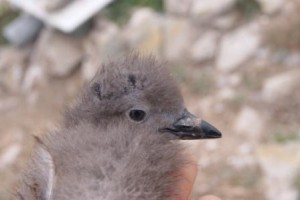 This is a partly-feathered Cassin’s Auklet chick that I weighed. It’s down is such a soft gray color! The iris of their eyes turns very milky-white at about age 4 or 5 years.
This is a partly-feathered Cassin’s Auklet chick that I weighed. It’s down is such a soft gray color! The iris of their eyes turns very milky-white at about age 4 or 5 years.
There also have been TONS of Cetaceans around the island this past week. We’ve been regularly seeing almost 100 humpback whales every day, including the usual 2 or 3 gray whales, and really exciting – 7 blue whales that have been hanging out! About 100 risso dolphins have also been feeding nearby, as well as some Pacific white-sided dolphins. I’ll bet there’s lots to see on those tourist whaler boats that come out here all the time. It’s kind of ridiculous how spoiled we get, if we only see a few humpback whales, the regular 2 gray whales, and a few other cetaceans, we’ll exclaim BORING! but in a kind of silly way because we totally know we’re so lucky to see all this amazing wildlife.
Anyway, I have to go back to entering data! I’m nearing the end of my 8-week stint here, which means I have to enter/analyze all the data onto computers that I’ve collected here out in the field so far. Hope you enjoyed the post (and don’t forget to check out the Farallon blog, Los Farallones! The link is at the top of the post!)
much love,
Kristina

